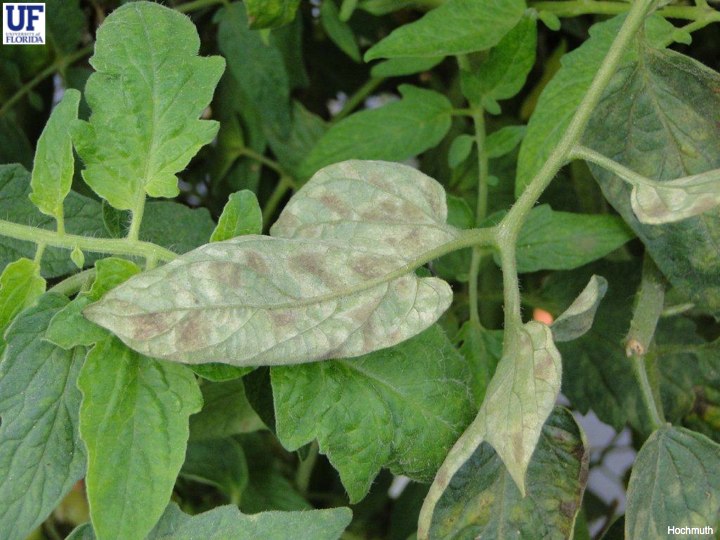High tunnels have gained popularity in Florida over the past 10 years. The USDA, Natural Resources Conservation Service EQIP program and others like it have increased high tunnel acreage in Florida from none being reported in 2001, to 186 acres in 2013 according to a UF/IFAS statewide survey. Although the use of this version of low-tech protected agriculture is being more readily accessed across Florida, most of the current use is by small farms, with just one or a few 2,000 to 3,000 square foot structures. With new production systems, comes new pests and diseases not previously dealt with.

Velvety like tan appearance on the underside of the leaf is a characteristic symptom of leaf mold. Photo Credit: Mathews Paret
Leaf Mold of Tomato
It is no secret that tomatoes, and specifically heirloom tomatoes, are a favorite crop for small farmers selling to direct markets. They do very well in high tunnels. This kind of production alleviates some of the disease and insect issues commonly dealt with in Florida. A new problem, however, has started to appear in high tunnels tomatoes called Leaf Mold. The fungus Fulvia fulva (also referred to as Passalora fulva) causes this disease and has a preferential growing environment of 85% or higher humidity, and temperatures ranging from 65 to 80 degrees Fahrenheit. This disease is not typical in field production, but the high humidity environment of high tunnel production, especially during periods rainfall, has made it a concerning problem.
The symptoms of leaf mold include light green yellow spots on the top surface of the leaf. As the disease progresses, the underside of the leaf begins to show velvety tan areas corresponding to where the yellow spots are on the top side of the leaf. The disease can cause the leaves to prematurely drop.
Although this is a fairly new disease for growers in the Panhandle of Florida, growers in northern states who have been using this production system longer have had more experience with this disease. University of Minnesota Extension recommends using resistant varieties on a small scale. Bear in mind, however, the resistant variety chosen may not have resistance to the race infecting the crop because of the many races of Fulvia fulva that could be attacking your plant. UM Extension also recommends the use of many cultural practices to increase air flow and reduce leaf wetness, such as using drip irrigation, pruning, and staking/trellising. They also have a short list of conventional fungicides to be used as a protectant during favorable conditions in the following publication: Leaf mold of tomato
Cornell University Cooperative Extension also has some information regarding leaf mold of tomato. Like Minnesota they recommend using resistant varieties, but warn that the disease has many races and that growers should grow several different resistant varieties to reduce risk. Here is a link to the Cornell University publication: Leaf Mold In High Tunnel Tomatoes
Although the University of Florida has not completed any research related to leaf mold of tomatoes in high tunnels, there are some practices that can reduce growers risk and help manage the problem. Here are a few practices to consider that may reduce risk for area high tunnel tomato growers:
- Crop Rotation – Tomatoes are a valuable crop and it is hard for a small grower who has only one high tunnel structure to rotate to other plant families, but it is an important management technique to help build the soil and prevent build up of diseases. A potential rotation could be as follwed:

- “Solarizing” the high tunnel – In between crops, in the middle of the summer, is an ideal time to clean out the high tunnel of crop debris, close the side walls and doors, and let whatever pathogens are on surfaces to “cook” in the resulting heat. A sheet of plastic can also be put over the soil to help solarize the soil. University of Kentucky Cooperative Extension provides information about solarizing in high tunnels in the following fact sheet: Horticulture Department Fact Sheet, Soil Solarization for High Tunnels
- Battling Scab in Panhandle Pecan Trees - September 22, 2017
- Where to Start with Marketing Fresh Produce? - April 28, 2017
- Using the Linear Bed Foot System for Vegetable Fertilization - August 26, 2016
